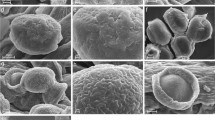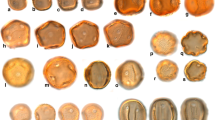Abstract
Pollen morphology of the four traditional genera (Paphiopedilum, Selenipedium, Cypripedium, Phragmipedium) comprising the cypripedioid orchids indicates that the monads are sulcate, more or less smooth-surfaced, and covered by a non-acetolysis resistant layer called elastoviscin. Evidence from ultrathin sections of pollen grains shows that typical exine layers are present only inSelenipedium, modified inPhragmipedium and absent inPaphiopedilum and most species ofCypripedium; that a small, inconspicuous portion of the grain surface is constructed as a sulcus; and that the pollen grain wall acts as a sponge in rapidly absorbing water. Several instances of parallelisms between non-related families and among different groups of orchids are reported and new ideas on the evolution of theCypripedioideae are presented.
Similar content being viewed by others
References
Atwood, J., 1984: The relationships of the slipper orchids (subfamilyCypripedioideae). — Selbyana7, 129–247.
Brieger, F. G., Maatsch, R., Senghas, R., 1971: UnterfamilieCypripedioideae. — InSchlechter, R., (Ed.): Die Orchideen (revised edition), pp. 161–198. — Berlin, Hamburg: Paul Parey.
Burns-Balogh, P., 1983: A theory on the evolution of the exine inOrchidaceae. — Amer. J. Bot.70, 1304–1312.
—, 1985: Evolutionary trends in the androecium of theOrchidaceae. — Pl. Syst. Evol.149, 119–134.
-Funk, V. A., 1986: A phylogenetic analysis of theOrchidaceae. — Smithsonian Contributions to Botany, no.61, 79 pp. — Washington, D.C.
Carniel, K., 1964: Beiträge zur Morphologie der Pollenkörner vonJuglans regia undJ. nigra. — Österr. Bot. Z.111, 555–560.
Cocucci, A., Jensen, W. A.., 1969: Orchid embryology: pollen tetrads ofEpidendrum scutella in the anther and on the stigma. — Planta86, 215–229.
Crane, P. R., 1985: Phylogenetic analysis of seed plants and the origin of Angiosperms. — Ann. Missouri Bot. Gard.72, 716–793.
Dressler, R., 1981: The Orchids, Natural History and Classification. — Cambridge (Mass.): Harvard Univ. Press.
Heslop-Harrison, J., 1976: The adaptive significance of the exine. — InFerguson, I. K., Muller, J., (Eds.): The Evolutionary Significance of the Exine. — London: Academic Press.
Hesse, M., Burns-Balogh, P., 1984: Pollen and pollinarium morphology ofHabenaria (Orchidaceae). — Pollen & Spores26, 385–400.
—, 1984: Sporoderm characters ofTetrameranthus duckei (Annonaceae) and their systematic implications. — Pl. Syst. Evol.147, 323–326.
Kurzweil, H., 1985: Vergleichend-entwicklungsgeschichtliche Untersuchungen an Orchideenblüten, unter besonderer Berücksichtigung des Gynostemiums. — Dissertation formal-und naturwiss. Fakultät, Universität Wien, Austria.
Morawetz, W., Waha, M., 1984: A new pollen type, C-banded and fluorochrome counter stained chromosomes, and evolution inGuatteria and related genera (Annonaceae). — Pl. Syst. Evol.150, 119–141.
Newton, G. D., Williams, N. H., 1978: Pollen morphology of theCypripedioideae and theApostasioideae (Orchidaceae). — Selbyana2, 169–182.
Payne, W., 1981: Structure and function in Angiosperm pollen wall evolution. — Rev. Palaebot. Palynol.35, 39–59.
Pfitzer, E., 1903:Orchidaceae-Pleonandrae. — InEngler, A., (Ed.): Das Pflanzenreich12 (IV. 50), 27–42.
Robinson, H., Burns-Balogh, 1982: Evidence for a primitively epiphytic habit inOrchidaceae. — Syst. Bot.7, 353–358.
Rolfe, R., 1896: TheCypripedium group. — Orchid Rev.4, 327–334, 363–367.
Schill, R., 1978: Palynologische Untersuchungen zur systematischen Stellung derApostasiaceae. — Bot. Jahrb. Syst.99, 353–362.
Schill, R., Pfeiffer, W., 1977: Untersuchungen an Orchideenpollinien unter besonderer Berücksichtigung ihrer Feinskulpturen. — Pollen & Spores19, 5–118.
Stoutamire, W., 1967: Flower biology of the lady's slipper (Orchidaceae: Cypripedium). — Mich. Bot.6, 159–175.
Van der Pijl, L., Dodson, C., 1966: Orchid Flowers, Their Pollination and Evolution. — Coral Gables: Univ. Miami Press.
Waha, M., 1987: Different derivation of fragile exines withinAnnonaceae. — Pl. Syst. Evol.158, 23–27.
-Hesse, M., in press: Aperture types withinSapranthus andPolyalthia (Annonaceae). — Pl. Syst. Evol.
Wolter, M., Schill, R., 1985: On acetolysis resistant structures in theOrchidaceae—why fossil record of orchid pollen is so rare. — Grana24, 139–143.
—, 1986: Ontogenie von Pollen, Massulae and Pollinien bei den Orchideen. — Trop. Subtrop. Pflanzenwelt56. — Wiesbaden, Stuttgart: Franz Steiner Verlag.
Author information
Authors and Affiliations
Additional information
Dedicated to Prof. DrE. Tschermak-Woess on the occasion of her 70th birthday.
Reprint requests toM. Hesse.
Rights and permissions
About this article
Cite this article
Burns-Balogh, P., Hesse, M. Pollen morphology of the cypripedioid orchids. Pl Syst Evol 158, 165–182 (1988). https://doi.org/10.1007/BF00936343
Received:
Issue Date:
DOI: https://doi.org/10.1007/BF00936343




